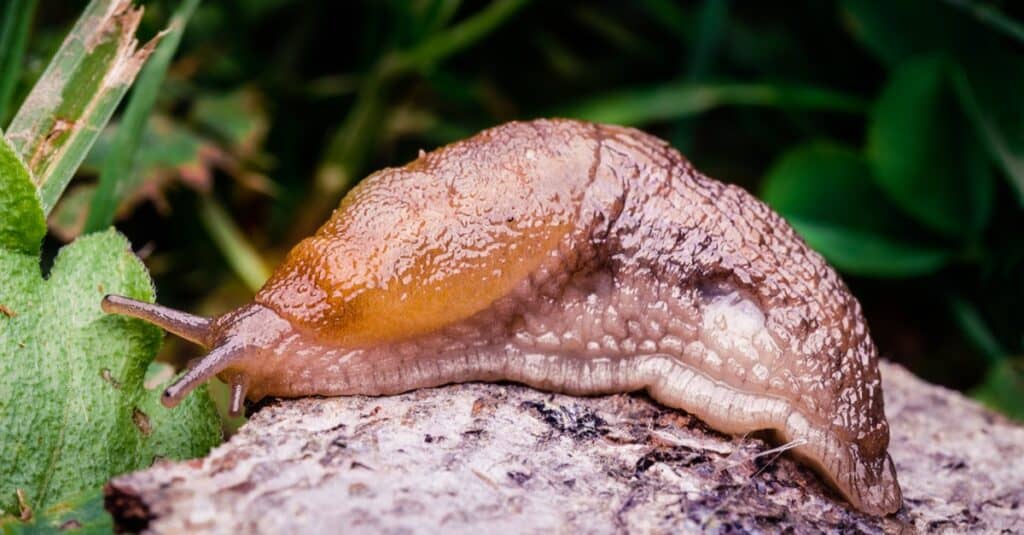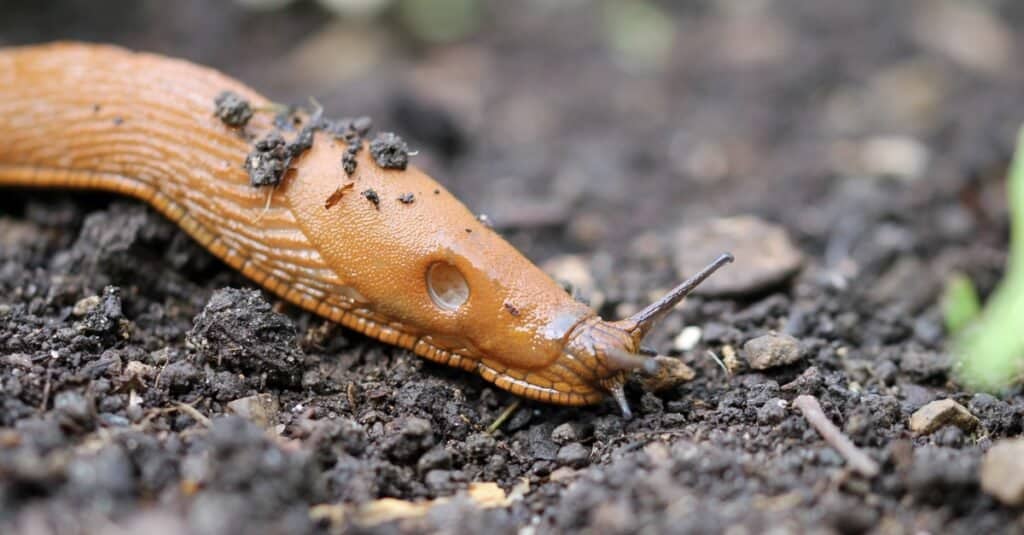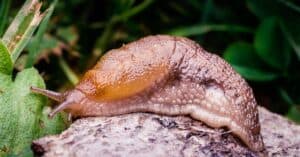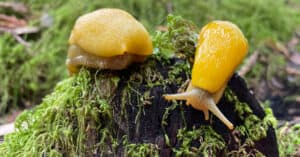Slugs are a common garden pest found worldwide. These slimy creatures feed on vegetation, leaving telltale trails of slug slime behind them. While most people think of slugs as summer pests, they are active year-round, even during the cold winter months. So, where do slugs go in the winter? Keep reading to learn more about these resilient creatures!
What Is a Slug?

Slugs come in various shapes, sizes, and colors.
©scott conner/Shutterstock.com
A slug, also known as a land slug, is not a species but a common name used for any terrestrial gastropod mollusc with little or no internal shell. The lack of an external spiral shell can distinguish slugs from snails. Sometimes, they are described as shell-less snails.
Slugs come in various shapes, sizes, and colors. They can range from very small to quite large. The leopard slug (Limax maximus), for example, can grow up to 8 inches long. Slugs have a unique physiology. Their sole, slimy, mucus-secreting foot helps them move along and glide over surfaces. They also use this mucus to protect their delicate body parts when moving in areas with sharp objects. Their bodies are made up almost entirely of water, reserving water in their mantle cavity (a section behind the head).
Slugs are hermaphrodites, meaning they have both male and female reproductive organs. Another unique slug characteristic is the head, which has two pairs of retractable feelers. The upper pair detect light, while the lower pair is used for smelling.
Although they are considered agricultural pests, slugs play an important role in the ecosystem by breaking down and recycling organic matter. They feed on organic materials, such as leaves from living plants, mushrooms, lichens, and carrions. They also consume vegetables, herbs, fruits, and flowers. Some species are predators and will eat snails, other slugs, and earthworms. However, they have many predators, too, including birds, reptiles, amphibians, and mammals.
Where Do Slugs Live?
Slugs prefer the vicinity of human habitations. They can be found in lawns, gardens, and other damp and shady areas near homes in drier conditions. When the temperatures rise, they hide beneath stones, logs, or other ground debris. Sometimes, they are found in damp, dark corners of basements or crawl spaces. Generally, slugs need moisture to stay hydrated, so they prefer areas with plenty of humidity.
Where Do Slugs Go in the Winter?

Slugs can stay active all year round in favorable conditions.
©Marek Mierzejewski/Shutterstock.com
In favorable conditions, slugs can stay active all year round. However, they are cold-blooded creatures, and, as such, they need a certain environmental temperature to keep their bodies warm.
During winter, some species opt for underground hibernation where temperatures rarely drop below 0°C. The species that don’t hibernate have a life cycle adapted to help them survive the winter. They spend the winter as eggs and hatch the following spring and early summer. On the other hand, some slug species die during fall.
Eggs laid in the fall overwinter in this stage, and the new slugs emerge when the weather improves. On average, slugs lay thirty eggs in sheltered cavities near the soil surface or beneath residue on moist soil surfaces. If the eggs are laid in the fall, it can take up to 5 months for them to hatch. Already hatched juveniles overwinter under debris, in compost heaps, burrows, and soil crevices. They are known to go without food for several months.
What Happens to Slugs When the Winter Ends?
Most slugs die only if exposed to frosty conditions for a long period. Due to increased soil moisture, those that survive start being active and return to the ground to feed.
Typically, adults use this time to feed and reproduce, laying eggs that will hatch in the spring or summer. If the soil temperature begins to rise (> 70°F) and moisture levels drop, they become less active on the surface. They rest in soil cracks, under residue, or in earthworm burrows until temperatures drop. This is an effective survival mechanism as it helps them avoid the extreme heat and drought of summer months. In the fall, slugs become active again when the soil temperature drops and moisture increases, entering a period of full reproductive activity.
How To Get Rid of Slugs During Winter?

Some non-chemical methods can be used to get rid of slugs during winter.
©Art_Pictures/Shutterstock.com
While most slugs are harmless to humans, a few species are serious agriculture and horticulture pests. As a control measure, you can try the below non-chemical methods that will help you get rid of slugs during winter:
Beer traps: Bury some containers you’ve previously cut a few holes into at about 1 inch in the ground and pour 2 – 3 inches of beer in them. The scent and taste of yeast found in beer attract slugs, so they will crawl into the containers and drown. If you have a slug infestation, one trap probably won’t suffice.
Crushed eggshells: The rationale behind this non-chemical method is that slugs are unable to crawl over the sharp edges of the eggshells and will eventually die if they don’t find moist soil or food.
Coffee grounds: The acidic nature of the coffee grounds increases their repellent effect against slugs.
Salt: Pour salt around your yard, as it causes the osmosis effect, which completely dries them out by drawing the water out of the slug’s skin.
Insecticidal baits: If non-chemical methods are ineffective, you can use insecticidal baits. These products contain iron phosphate and should be sprinkled around nibbled plants where slugs hide.
Up Next:
- 10 Incredible Slug Facts
- Slug Poop: Everything You’ve Ever Wanted to Know
- 10 Incredible Sea Slug Facts
The photo featured at the top of this post is © Lisa-S/Shutterstock.com
Sources
- Animal Diversity Web, Available here: https://animaldiversity.org/accounts/Arion_lusitanicus/
- University of Minnesota Extension, Available here: https://extension.umn.edu/yard-and-garden-insects/slugs
- OSU College of Agricultural Sciences, Available here: https://agsci.oregonstate.edu/slug-portal/life-slug/biology-and-life-cycle-gray-field-slug
Thank you for reading! Have some feedback for us? Contact the AZ Animals editorial team.






